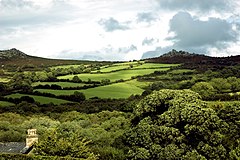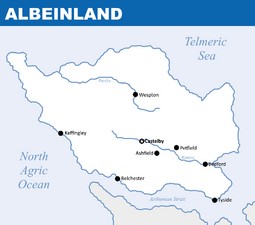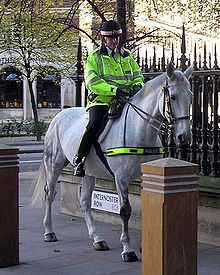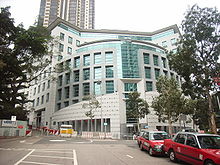Albeinland: Difference between revisions
| Line 166: | Line 166: | ||
{{main|Foreign relations of Albeinland}} | {{main|Foreign relations of Albeinland}} | ||
[[File:HK_British_Consulate_Justice_Drive_1.JPG|thumb|right|220px|The [[Embassy of Albeinland, Paradise City|embassy of Albeinland]] in [[Paradise City]], [[Blackhelm Confederacy]]]] | [[File:HK_British_Consulate_Justice_Drive_1.JPG|thumb|right|220px|The [[Embassy of Albeinland, Paradise City|embassy of Albeinland]] in [[Paradise City]], [[Blackhelm Confederacy]]]] | ||
Albeinland maintains diplomatic relations with almost every sovereign country in [[Astyria]], with its [[Cabinet of Albeinland|Foreign Office]] being one of the oldest diplomatic offices to be established in [[Lorecia]]. The Albish foreign policy is largely shaped around the principles of {{wp|free trade}}, {{wp|democracy|democratic relationship}} and [[Lorecia|Lorecianism]], with the last being introduced after a series of diplomatic changes in its policy to avoid bigger protagonisms in the [[Cold War Exponent|Astyrian Cold War]]. | Albeinland maintains diplomatic relations with almost every sovereign country in [[Astyria]], with its [[Cabinet of Albeinland#Current cabinet|Foreign Office]] being one of the oldest diplomatic offices to be established in [[Lorecia]]. The Albish foreign policy is largely shaped around the principles of {{wp|free trade}}, {{wp|democracy|democratic relationship}} and [[Lorecia|Lorecianism]], with the last being introduced after a series of diplomatic changes in its policy to avoid bigger protagonisms in the [[Cold War Exponent|Astyrian Cold War]]. | ||
[[File:Theresa_May_portrait.jpg|thumb|left|135px|[[Charlotte Hastings]], [[Cabinet of Albeinland|Foreign Minister]]]] | [[File:Theresa_May_portrait.jpg|thumb|left|135px|[[Charlotte Hastings]], [[Cabinet of Albeinland|Foreign Minister]]]] | ||
Revision as of 19:09, 28 April 2019
Kingdom of Albeinland | |
|---|---|
Motto: Libertas quæ sera tamen "Liberty albeit late" | |
 Albeinland (dark green) in the Lorecian Community (light green) | |
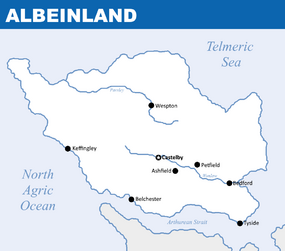 Political map of Albeinland | |
| Capital and largest city | Castelby |
| Official languages | English |
| Ethnic groups (2018) |
|
| Demonym(s) |
|
| Government | Unitary parliamentary constitutional monarchy |
• Monarch | Catherine II |
| Vincent Lloyd | |
| Legislature | Royal Assembly |
| Establishment | |
• Foundation of Castelby | 5th century AD |
• Unification | 12 December 1016 |
• Albish Revolution | 16 August 1663 |
| Area | |
• Total | 1,291,800 km2 (498,800 sq mi) |
| Population | |
• 2019 estimate | 30,969,622 |
• 2018 census | 30,968,221 |
• Density | 23/km2 (59.6/sq mi) |
| GDP (PPP) | 2018 estimate |
• Total | £1.214 trillion |
• Per capita | £38.307 |
| GDP (nominal) | 2018 estimate |
• Total | £1.239 trillion |
• Per capita | £41.315 |
| Gini (2018) | low |
| HDI (2018) | very high |
| Currency | Sterling (£) |
| Time zone | UTC+1 (UTC) |
| Date format | dd-mm-yyyy |
| Driving side | left |
| Calling code | +36 |
Albeinland, officially the Kingdom of Albeinland, is a sovereign state in west Lorecia, sharing borders with Noordenstaat and Fyngaria to the south, Arstotska and Aswick to the northeast and Aurora Confederacy to the northwest. Its territory is composed of the Alban Highlands and Lowlands on the mainland and the islands of Arsey, Brenswick, Brunhill and Lanwel on the Albish Channel. The country has an estimated population of 30 million inhabitants, most of them living in urban spaces such as the capital and largest city, Castelby. Albeinland is a member of the World Assembly since 1991 and is one of the founding states of the Lorecian Community in 1994.
The area that now encompasses Albeinland was settled by Arlethian tribes, an ethnolinguistic group who is the ancestor of several modern peoples in Lorecia from the 1st century BCE until its Christianisation in the 6th century CE. The first Christian missionaries arrived in the 5th century and established several churches and monasteries, with local natives and its tribes developing and founding the Kingdoms of Anglea and Cambria and the Duchy of Lencester in the early 7th century. In 1016, after countless wars and conflicts, the House of Annesley of Anglea rose to unify the Albish territory, with Arthur of Anglea becoming the first sovereign of a united Albeinland. The middle ages were the scene of military conquests which consolidated the Albish state.
Despite the creation of a legislative body in the 14th century, the King Council's minimal jurisdiction and the sovereign's disproportionate authority spawned the first clashes between the two powers, which would only worsen over the years. In the 16th century, most of the Albish population converted to Protestantism, giving to the monarch more powers over the council with the creation of the Church of Albeinland. The final spark came in 1663, when the Albish Revolution began and divided the nation between constitutionalists and absolutists, ending with a rebel victory and the introduction of a constitutional monarchy. The 17th century was a golden age for national politics, economy and philosophy while the 18th century witnessed the introduction of modern democracy, with universal male suffrage being enacted in 1872 and women's suffrage in 1919.
Today, Albeinland is a developed country operating under a parliamentary constitutional monarchy, with Catherine II acting as Monarch and Vincent Lloyd as Chancellor. The country is a member state of the Lorecian Community and the World Assembly.
Etymology
The name "Albeinland" is derived from the Old English Albaland, which means "land of the Albans". The Albans were one of the Arlethic groups who settled the current Albish territory in the 1st century BCE until their Christianisation in the early 7th century. Its earliest recorded use, as Albalanda, comes from a Christian chronicle dated to the 6th century, however, this name has another meaning: "white land" or "white ground". Etymologists believe that the name derives from the harsh winters in the region, causing the Arlethians who settled in the area to begin calling themselves as "the white people".
Neither the Royal Assembly nor Government recognises the gentilics Alban or Albian as wrong, however, the official documents issued by both uses the term Albish to avoid any historical confusion.
History
Geography
Albeinland has a total area of 1,291,800 square kilometres, with the majority being located on the Astyrian continent of Lorecia in addition to the islands of Arsey, Brenswick, Brunhill and Lanwell on the Albish Channel. Albeinland is one of the biggest countries in the Lorecian Community, sharing borders with several countries such as Noordenstaat and Fyngaria to the south, Arstotska and Aswick to the northeast and the Aurora Confederacy to the northwest.
The continental landscape of Albeinland is comprised of mountainous regions and plateaus. The largest mountain range is the Apperlane Mountains, which are concentrated along the Albish border with Aswick and Fyngaria, in the provinces of Cambria and Bedfordshire. Albeinland has five mountains with peaks over 1,000 metres; Effing Pike in southeast Cambria is the highest, at 4,018 metres. Owing to their altitude, the Apperlane Mountains restrain the air flow coming from the ocean and South Lorecia, thereby keeping the temperature unusually cool for its latitude and in comparison with its neighbours.
Most of the Albish territory is characterised by the Alban Highlands - a series of plateaus and high terrains that encompass almost all of the national land. The several small mountains and plateaus in the central region up to the coastline ranges from 200m to 400m in altitude, with Castelby being 250m above sea level while Eidenburgh and Bedford are 300m above sea level. Despite being at relatively high altitudes for Lorecia, the Albish terrain is not particularly rough, helping in the defence of major cities in medieval times and not negatively affecting to great extent agriculture in the region. The Highlands extends into the Albish coastline, gradually transitioning to become the Alban Lowlands in the coastal cities of Lenderpool, Forrest and Sunnaway.
The main rivers in Albeinland are the Kensingley, Ossey and Hammerworth, all of them rising in the Apperlane Mountains and flowing into the Albish Channel. The three rivers and their tributaries are crucial for maintaining the agriculture and industry in Lencester as well as supplying water to the biggest cities. The majority of the Albish lakes are located in the province of Bedfordshire in a region known as Lake Lands. The most important lakes within the country are Lake Victoria and Lake Everest, near the Aswickan border.
Climate
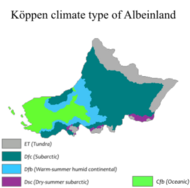
| Castelby, Albeinland | ||||||||||||||||||||||||||||||||||||||||||||||||||||||||||||
|---|---|---|---|---|---|---|---|---|---|---|---|---|---|---|---|---|---|---|---|---|---|---|---|---|---|---|---|---|---|---|---|---|---|---|---|---|---|---|---|---|---|---|---|---|---|---|---|---|---|---|---|---|---|---|---|---|---|---|---|---|
| Climate chart (explanation) | ||||||||||||||||||||||||||||||||||||||||||||||||||||||||||||
| ||||||||||||||||||||||||||||||||||||||||||||||||||||||||||||
| ||||||||||||||||||||||||||||||||||||||||||||||||||||||||||||
Albeinland is considered one of the coldest countries in Lorecia, with the average temperature varying between -2°C to -15°C in the winters and 5°C to 18°C in the summers. The coldest months are December and January, while June and July are the hottest. According to the Köppen climate classification, about 40% of the Albish territory has a cool temperate climate with stiffer winters and mild summers, with cities such as Castelby, Bedford, Eidenburgh and Rosefort commonly suffering snowstorms in the winters and having a cool climate in the summers followed by a transitional humid continental climate between the coastline and countryside. The Albish coast has an oceanic climate with mild winters and warmer summers. The major reason for the low temperatures in Albeinland is due to the Apperlane Mountains that restrains the cold streams coming from the Albish Channel.
In the more mountainous regions such as the Apperlane Mountains, the tundra biome predominates, with temperatures remaining below zero almost all year. Since the Alverville Observatory began to record the weather in 1952, the highest temperature ever recorded was 37°C on August 2007 in Hampsey and the coldest temperature being -41°C in Pendston on March 1994.
Biodiversity
Albeinland has a diverse fauna and flora, despite sharing many species in common with other Lorecian countries. The Albish oak is considered the national tree due to its high presence in the region, having a darker log compared to a common oak which allows the creation of houses and furniture with its wood. In terms of fauna, the country has a series of mammals such as the Albish fox, red deer, squirrels and ferrets.
Politics

Since the enactment of the Common Charter in 1665, Albeinland is a unitary parliamentary constitutional monarchy, with the Chancellor acting as the head of government while the monarch acts as the head of state and constitutional protector, supervising the Albish political system to avoid and combat irregularities from both government and opposition.
The Chancellor is the head of government of Albeinland, being the equivalent of a prime minister in other Lorecian countries. The Chancellor role is to lead both executive and legislative alongside its Cabinet, being appointed by the monarch after elections or the resignation or incapacitation of the former occupant of the office. The Chancellor's office is one of the oldest offices of Albeinland, being created in 1665 and having its origins on the King's Council.
The national legislature of Albeinland is the unicameral Royal Assembly, being composed of 160 Assembly Members elected in a party-list proportional representation. The Royal Assembly has its origins on the King's Council - an advisory council composed by peers, commoners and the clergy with the role of advising the sovereign actions and govern the country in cases of war or regency. After the end of the Albish Revolution in 1665, a series of reforms in several institutions were enacted, with the King's Council becoming an independent legislative body with the duty of approving laws and supervise the government's work.
Monarchy
The Monarchy of Albeinland has its origins on the monarchies of the Kingdoms of Anglea and Cambria before the unification of Albeinland by Arthur I in 1016. Between the unification and the Albish Revolution, Albeinland was an absolute monarchy, with the monarch holding unlimited temporal and spiritual powers. In some special cases such as the regency of a sovereign or wars, the monarchs could create a cabinet composed of ministers, although not necessarily being a rule.
The absolute powers of the sovereign led to several conflicts against the rising bourgeoisie and aristocracy, who only worsened over the years. In 1663, after the Albish defeat against the Empire of Exponent at the Battle of Lochfield, the Albish Revolution begun, with a series of rebel nobles and commoners fighting against the absolutist status quo. The rebel victory two years later established a constitutional monarchy, with the monarch having lesser rights than before and giving to the newly-created office of Chancellor more executive and legislative powers such as leading the government.
Despite the powers of the monarch were limited after the Albish Revolution, the Albish monarch still holds a considerable amount of official, ceremonial and religious duties within the country such as appointing the Chancellor, dismiss the Royal Assembly and convoke new elections.
Administrative subdivisions
The subdivisions of Albeinland consist of three levels of subnational division made with the purpose of organising the Albish territory through local governments. The highest tier of national subdivisions are the provinces, which were created in the 17th century to allow the Albish government to create more flexible policies based on regional issues. Each province is headed by a Royal Commissary appointed by the monarch to represent the Albish Government and Monarchy locally. Despite being the main subnational division of Albeinland, the provinces and its Government Offices doesn't have any kind of autonomy and legislative powers, acting as a ceremonial administrative tier.
Followed by the provinces, the second tier of national subdivision in Albeinland is the counties, which also are one of the oldest administrative subdivisions in the country, being established in the Middle Ages. Since 1872, the counties are divided into two types: the metropolitan counties and non-metropolitan counties. The metropolitan counties are counties comprised of urban perimeters with a population of above seven hundred citizens, having a town council which purpose is to provide public services to the town. Non-metropolitan counties also share most of the functions of a metropolitan county.
Districts are the third and most basic tier of administrative subdivision, being classified into three types: parishes and towns in non-metropolitan counties and wards in metropolitan counties. In non-metropolitan counties, the title of parish is given to rural districts and hamlets while the title of town is given to villages or county capitals. Both types of districts have the same roles such as the maintenance of pavements, parks, squares, public clocks and roads, as well as to elect one councillor to represent the district in local authorities. In metropolitan counties, the wards have a more ceremonial role although still managing to elect one councillor to the town council.
The local authorities (or town councils in metropolitan counties) acts as legislative assemblies for the counties, being responsible for governing and provide public services such as police, health and education for the county. The local authorities are made by elected councillors from each district, with the leader of the local authority generally receiving the title of mayor. In the province of Greater Castelby, there's no county, with each ward having both county and district administrative functions.
Law and criminal justice
The Albish legal system is based on the common law - which is applied in most anglophone countries in Astyria and developed along the centuries until its current way. The highest judicial court in Albeinland is the Royal Courts of Justice, who acts in both criminal and civil cases and is the last instance in the Albish judiciary system, followed by regional courts. The Royal Assembly has a special committee to investigate and judge judicial processes against Assembly Members.
The Albish Police Service is the main law enforcement agency of Albeinland, being a civilian police force. Crime in Albeinland always remained bellow than the Lorecian average, although an increase between 1986 and 1992 followed by a decline in the next years. According to Her Majesty's Prison Service (the government agency responsible for most of the prisons), around 32,000 Albish citizens are incarcerated in several prisons within the country.
Foreign relations
Albeinland maintains diplomatic relations with almost every sovereign country in Astyria, with its Foreign Office being one of the oldest diplomatic offices to be established in Lorecia. The Albish foreign policy is largely shaped around the principles of free trade, democratic relationship and Lorecianism, with the last being introduced after a series of diplomatic changes in its policy to avoid bigger protagonisms in the Astyrian Cold War.
Today, Albeinland enjoys diplomatic alliances and trade agreements with the majority of the western Lorecian countries such as Noordenstaat, Fyngaria and Nidwalden due to its condition as a member of the Lorecian Community since 1994. In 2002, Albeinland's Foreign Office started to approach diplomatically to the Kingdom of Great Nortend, with a brief suspension of such talks between 2011 and 2018. In April 2019, the Albish Chancellor Vincent Lloyd made an official visit to the country with the purpose of better trade conditions, implying the creation of an alliance between the two countries.
Alongside Great Nortend and most of the Lorecian countries, Albeinland shares historical alliances with the Blackhelm Confederacy and is a member of several international organisations such as the Lorecian Community, T5 Council, the International Court of Astyria and the Astyrian Postal League.


